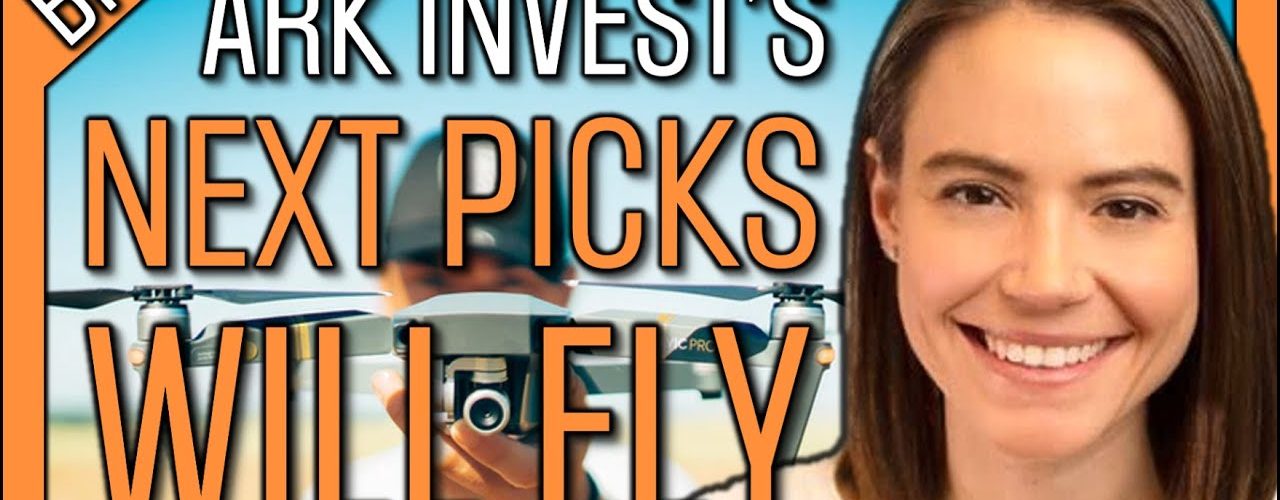Resources:
- ARK Invest Innovation ETF (ARKK) – https://ark-funds.com/arkk
- ARK Invest Genomic Revolution ETF (ARKG) – https://ark-funds.com/arkg
- ARK Invest Autonomous Technology & Robotics ETF (ARKQ) – https://ark-funds.com/arkq
- ARK Invest Next Generation Internet ETF (ARKW) – https://ark-funds.com/arkw
- ARK Invest Fintech Innovation ETF (ARKF) – https://ark-funds.com/fintech-etf
- Support the channel and get extra member-only benefits by joining us on Patreon: https://www.patreon.com/tickersymbolyou
#ARK Invest released #BigIdeas2021 this past January and Cathie Wood announced ARK's new space exploration fund, #ARKX, which will debut in late March 2021. NASA's Perseverance mission successfully landed an autonomous drone on Mars in mid-February. Drone stocks are going to fly high as they disrupt multiple industries and market sectors. ARKX will hold companies like Virgin Galactic (SPCE stock) and Lockheed Martin (LMT stock). It may even hold Tesla stock as an enabling technology company (think solar panels and energy storage).
Stocks featured in this video are ARKK, ARKQ, ARKX, AeroVironment (AVAV), Brainchip (AZKLF), Garmin (GRMN), Ondas Networks (ONDS), Amazon (AMZN), NVIDIA (NVDA), UPS (UPS), Workhorse (WKHS).
Video Transcript:
[00:00:06.230]
Let's talk about drones. One of the best mental exercises you can do as an investor is to daydream. No, seriously, I'm not a financial advisor, but every once in a while, I try to sit down and think about my own vision for the future, because that forms the context for my own investment decisions. To me, investing is exciting because the future is exciting. Advanced technology is changing the way we work, the way we play, the way we communicate and the way we travel. When it comes to ARK Invest,
[00:00:34.080]
the thing that stands out the most to me is they also have this passion for advanced technology, which makes their ideas about investing exciting. Each year they sit down and map their vision of the future onto the stock market, and each year they identify new advanced technologies that make the near future feel even more exciting. These technologies are jumping off points for innovation, their platforms for solutions to many different challenges across industries, market sectors and geographies. They really are big ideas.
[00:01:03.480]
And to me, the most exciting big idea of all is the aerial drone. Not just delivery drones, every kind of drone. Drones are electric vehicles. They're becoming increasingly automated and they'll one day transport people as air taxis and air ambulances. They will also be an essential part of our worldwide logistics and delivery networks. Teslas are just drones on wheels. Today, they're still piloted by humans, but one day they will be autonomous electric vehicles providing transportation as a service.
[00:01:33.880]
I like to define drones as mobile robots. The word mobile can mean many different things, and as a result, drones can take on many forms. Then aerial drones are just aerial mobile robots. Simple enough, right? Aerial drones were their own big idea in 2020, that's anything from a pizza delivery drone to an air ambulance, to an Amazon warehouse in the sky. Yeah, we'll get back to that one in a bit. What about other forms of drones?
[00:02:00.300]
The autonomous space for drone ship or Space X's ASDS is an autonomous drone that allows the reusable rockets to make seaborne landings before transporting them back to land. Not everything the ASDS does is autonomous. It can also be remotely controlled when needed. This flexibility and control from remote piloting to AI assistance to full on autonomy is one of the things that makes drones truly special. It doesn't just open the doors to a few new applications, it blows those doors off altogether.
[00:02:30.840]
Let's start with the opportunities for drones that ARK Invest thinks will happen first and then I'll add some of my own pie in the sky ideas. Here's Tasha Keeney, ARK Invest's analyst focused on autonomous technology and robotics strategy. At ARK Invest, she covers infrastructure development, autonomous mobility, 3D printing and innovative materials, the exact combinations of technologies that are converging on drones. This interview between Tasha and Livewire Markets took place roughly a year ago. So while some of the numbers she mentions are a little different from the slides in the latest Big Ideas presentation, ARK Invest's vision for an exciting drone-filled future remains unchanged.
[00:03:11.130]
Same with their investment thesis in it.
[00:03:13.740]
So drones can be delivering parcels, medical supplies. Actually, they're delivering medical supplies in China today, food… And there are also larger form factor drones that will likely come later that could deliver people. So these are pilotless vehicles that could fly around. And this is particularly disruptive. If you think about things like cardiac arrest, drones are bringing down delivery costs to a tenth of what they are without autonomous electric technology. So twenty thousand people per year that get cardiac arrest outside of a hospital,
[00:03:49.440]
only 10 percent of those people survive. So this is something where response time really matters. So if you can get to someone as the crow flies, you can actually save their life. Drones are so interesting, I think they'll completely change shopping behavior. So, ecommerce as a percentage of retail today is about 14 percent globally. We think that could go to 60 percent in the next 10 years and that drones could deliver perhaps half of that. Drones are bringing down delivery costs to a tenth of what they are without autonomous electric technology. For food delivery,
[00:04:26.070]
food delivery as a percentage of global food spend today is about one percent. We think that could go to 40 percent. And again, about half could be delivered by drones. So it's just another thing like autonomous cars that are sort of bringing money back into consumers pockets and sort of lowering costs for them and sort of making that process seamless. There's a lot of regulatory questions with drones. I actually think Australia could be one of the first markets to see this technology because it's a more friendly regulatory environment than the US.
[00:04:54.190]
So we think that the opportunity for drones overall, if you look at food, parcels and delivering people, this could be a three hundred billion dollar market in the next 10 years. I think companies that could lose in the US would be companies maybe like FedEx that aren't as quick to adapt. FedEx lost their Amazon contract, UPS is very aggressively moving in on drones. So if you're a logistics provider and you don't sort of look to these next-generation technologies, you might not be around in 10 years.
[00:05:25.140]
Yikes. Looks like we better start digging into companies investing in drones for parcel delivery, industrial applications and transportation, as well as companies developing the sensors, processors and advanced materials that will enable them. Let's start with some companies ARK Invest is already involved with and then I'll add a couple of my own stock picks that even ARK Invest isn't holding (yet). By the way, none of this is investment advice. Amazon is working on delivery drones through their Prime Air program.
[00:05:53.730]
Amazon also owns Ring, a modular home security systems company that sells Internet-enabled doorbells cameras and you guessed it, domestic drones. Oh, my. Many drones map their environment in real-time and figure out where they are in it so that they can plan the safest and most energy-efficient paths of travel and find safe spots to land. This act of mapping your own environment and figuring out where you are in it at the same time is called Simultaneous Localization And Mapping or SLAM.
[00:06:24.450]
SLAM is a huge topic within the field of computer vision that's used in self-driving cars, unmanned aerial vehicles, self-guiding missile systems, autonomous underwater vehicles, planetary rovers like the Perseverence Rover, which successfully landed on Mars on February 18th, 2021, and even more exciting and advanced applications like Robot Dragon hybrids designed to protect high priority domestic assets. If this doesn't convince you of the convergence. I'm not sure what will. OK, OK, here's a cooler version of a Robot Dragon hybrid.
[00:06:58.940]
So awesome. I said earlier that flexibility and control ranging from remote piloting to AI assistance to full-on autonomy is one of the things that makes drones truly special. This area of computer vision and artificial intelligence more broadly is the secret sauce behind that. As part of their BIS2020 series, Tasha Keeney interviewed Adam Bry, the CEO of Skydio, on the state of the art when it comes to consumer and industrial applications for drones. As it turns out, Skydio thinks of drones as innovation platforms as well.
[00:07:31.160]
And by really focusing on this sensing, processing, and navigation area, Skydio has blown the doors off the amount of applications their drones can handle. Here, let me show you. Using object recognition, you can tell the drone to follow a target. It will fly a circular path if the target is stationary or follow if the target is moving. That's pretty cool when you're skateboarding or mountain biking. But it turns out, that's also the same thing as tactical overwatch: type a point on the ground,
[00:07:58.190]
and give the drone an altitude and a radius and it will fly a ring around the target while avoiding obstacles automatically. Click on a car instead of your buddy and your drone is now tracking that or just tell it to look out for humans in areas where you don't expect humans to be and the drone will terminate, I mean, track the anomaly. All kidding aside, I hope you're starting to see that this one idea, essentially a cell flying set of eyes, has an unbelievable total addressable market.
[00:08:24.500]
Let's keep daydreaming up some more capabilities of this big idea. If you're willing to add in a radio beacon, the challenge of target tracking becomes much simpler and the total addressable market becomes much bigger. A beacon is a device that emits a signal for the drone to hone in on. Because the beacon is constantly emitting a signal, the drone can track you even when it can't see you with cameras. It's actually just aligning to the beacon. The stronger the signal the beacon emits, the further away the drone can track the beacon.
[00:08:52.100]
So even though the target is getting smaller and smaller to an optical camera, the drone has no issues. The military version of this application might be dropping a hidden beacon or a tracking device on an unsuspecting target and then tracking that beacon. Or instead of a physical device, you can shoot a powerful laser at something and track the signal returning from that laser as if it was a beacon signal. At a high level, that's always where guidance is, you paint a target with the laser and then outfit your drone with a system that seeks the reflection of that laser.
[00:09:23.840]
And that's why combat aircraft have flares. When they get painted with such a laser, they throw off other sources that confuse the missile following that laser. By the way, there's nothing stopping drones from launching other drones, just like we saw in this concept for the flying Amazon warehouse. But for combat applications like AeroVironment Family of Loitering Missile Systems. AeroVironment's ticker symbol is AVAV. And ARK Invest currently holds over 70 million dollars of it in ARKQ, ARK Invest's fund themed around the autonomous revolution.
[00:09:54.830]
I strongly suspect that AeroVironment will also be included in ARKX, ARK Invest's fund themed around space exploration enabling technologies and beneficiaries, which is launching at the end of March of 2021. Now let's do the craziest thing we can think of. Let's give a human full control of all of this technology. Let's do the second craziest thing we can think of. Let's give a human full control of all of this technology while still enabling obstacle avoidance with AI assist. If the drone can do the flying while the owner focuses on the actual task at hand, the use cases are virtually unlimited.
[00:10:31.790]
What about a construction site? Mapping out the area is a great way to survey the whole site quickly. The same map allows you to inventory which materials, machines and other resources and assets are on site as well as where. But you can also use the same aerial imagery in other interesting ways. For example, you can do volume calculations, which means you can assess how much of each material is in each pile very quickly. OK, what about scanning and mapping a more complex surface?
[00:10:58.880]
Using similar math, you can reconstruct even more complex structures and inspect their surfaces, turning tedious and very difficult inspections into much easier jobs. Seriously, how do you even see if we get a human inspector into some of these spots in a way where they can take pictures and record data safely? What if that cluttered environment was a disaster zone? Mapping out disaster areas could be a huge help to first responders. Inspecting structures for serious damage could save lives by alerting those same responders to the potential of collapse.
[00:11:29.930]
And the thing we're scanning this complex scene for, it could be a survivor trapped in the rubble. What if that disaster zone is constantly shifting, moving and degrading? In 2015, an intense earthquake struck Nepal, killing 9000 people and injuring over 20000 more. It was the worst natural disaster to strike Nepal in over 80 years, destroying centuries-old cultural buildings, thousands of homes across multiple urban centers and displacing hundreds of thousands of Nepalese. To us, it was just a tragic news story, but to them, it was a localized apocalypse.
[00:12:04.070]
PIX4D, a software developer that converts aerial imagery into survey-grade two-dimensional mosaics, as well as three-dimensional point clouds went on a week long UAV training mission to Nepal. They taught engineering students how to use image processing software and DJI'sconsumer-grade consumer grade drones to create some stunning maps of the damage. Here's a tiny clip from PIX4D's humanitarian efforts. This is truly incredible work.
[00:12:31.520]
PIX4D mapper takes images and creates professional maps and models for a variety of industries. You start with our automatic processing and you'll get a quality report that shows all the data and what type of accuracy you can expect from your project. How it works is the software will match thousands of points from the images you've collected, and it creates a three-point cloud that represents the real surfaces of an area. These original images are then projected onto the surface of the site, creating a 2D map or what we call the mosaic. Because it's high resolution,
[00:13:07.930]
it's really valuable data. You can see streets, schools, damaged structures as you would from an aerial perspective, but you don't have the distortion. Elevation is computed as well, so distances, slopes, volumes, they can all be calculated in the software. The data we have here really contains invaluable up to date information that can be used for risk damage assessment, reconstruction, emergency planning. Really, the possibilities are endless. Now, imagine what kind of things we could do if we built vertically integrated application specific drone solutions from the ground up instead of simply repurposing consumer grade drones. Like this drone, designed by WindHorse Aerospace to store as much food, supplies, and medicine as possible and whose frame can be used as a shelter or burned for heat.
[00:14:00.230]
OK, let's talk drone stocks. Here's Tasha Keeney discussing ARK Invest's current vision of a drone-filled future and their current investment thesis in it, on a recent episode of TD Ameritrade's Morning Trade Wire.
[00:14:13.370]
What's the best way to invest in it? Do you just stick with Amazon on the margin expansion that'll happen or stick with the delivery companies? Or can you actually buy drone stocks or… I know you mentioned some of the mapping companies as well. Like, are there unknown players that are exposed to this more directly and with higher beta than the delivery companies?
[00:14:34.490]
We think that this could be an industry worth over a hundred billion by 2030. But more importantly, it'll give players like Amazon this really solidified position as a logistics Goliath because they always want to delight the consumer. This is just another way to do that. The research that I've done has showed that the services side of this business could actually be a lot more profitable than just making the hardware itself. So companies that are basically able to capitalize on its drone delivery platform are the ones you want to look out for.
[00:15:04.430]
So it seems like this is a pretty interesting market, but publicly traded options still somewhat limited, Tasha. You guys have these in your ARK funds right now?
[00:15:14.900]
We do. We have some of the military drone companies. AeroVironment, like I mentioned earlier, is another military company that's starting to do a lot of surveys or another sort of government-based company that's doing a lot of surveillance, imaging applications. And then, of course, we hold players like Amazon that that sort of run the logistics network.
[00:15:33.200]
Here are three additional drone-related stocks that my Discord community has let me know about. By the way, my Discord community is now at over 5000 members and there's a dedicated channel for each of ARK Invest's funds and clusters of big ideas. There's a channel focused on autonomy, one for artificial intelligence, electric vehicles and 3D printing, all of which are converging on drone technology companies that will sit inside ARKQ and the upcoming ARKX. I'm only bringing it up because I try to give credit where credit is due, and I'm fortunate enough to have so many active members sharing investment opportunities with me as well as each other.
[00:16:09.890]
I will leave an invite link to the Discord community in the description below. The first stock is Garmin, ticker symbol GRMN, which makes GPS-enabled products. Everything from smartwatches and rescue beacons to more advanced GPS receivers and sensor packages that go in airplanes, ships, cars and of course, drones. I believe Garmin could find its way into ARKX, ARK Invest's upcoming fund that will be filled with technology companies focused on enabling or benefiting from space exploration. Garmin is up about 15 percent since the start of February 2021.
[00:16:45.050]
Ondas Networks, ticker symbol ONDS, is focused on providing wireless connectivity to industrial assets and making them a part of the Internet of Things. They upgrade assets with software defined radios, kind of like how Garmin does with GPS systems to give wireless command and control capabilities to things like freight rail, powerplants, oil rigs and so on. They are also working with Aura Networks to form the first nationwide commercial drone network, which means long-distance connectivity and communications for drones and anything a drone can relay a signal to.
[00:17:18.980]
That's a big idea. The last company is called Brainchip, ticker symbol AZKLF. Just like the last two picks, this company builds hardware and software that can be put on a ton of devices to locate, connect and control them. Brainchip makes small low-power microchips for artificial intelligence applications at the edge, meaning the chip can take in sensor data, like from a Garmin GPS and communications data like from Ondas's radios, and do the complex math without needing to talk to a controller or a server first.
[00:17:51.170]
The Brainchip architecture is scalable, which means they can have a smaller product for consumer drones, a bigger one for air taxis and an even bigger one for autonomous cars and so on without having to create separate products for each. So there you go, three stocks I'm continually researching and building my own position in, that I wouldn't be surprised to see in ARKX or ARKQ based on everything we've covered in this video. Speaking of this video, Ticker Symbol: You now has an
[00:18:19.310]
editor. I'm really excited to take my financial storytelling from this to this, it's been tricky managing Ticker Symbol: You and my day job. My boss hates me. Sharing this project with somebody else was a big decision. But in doing so, I gain more than double the time to do the stuff I'm actually good at: researching, connecting dots and writing about it.
[00:18:39.020]
I tend to think of myself as a one-man wolf pack. And my wolf pack, it grew by one.
[00:18:45.860]
Now that this is a wolf pack of two, I can also engage more with my community members that made this possible. So a huge thank you to my over one hundred patrons on Patreon and almost one hundred YouTube channel members. Your extra support for the channel has unlocked more research per video and hopefully more videos per month. I hope you see that your investment in me is paying off big time. And speaking of engaging with the community, comment below and tweet me your thoughts.
[00:19:12.440]
Do you think drone technology will impact the world? Are you starting to look into more technology companies focused on drones, enabling technologies and beneficiaries? Are you already invested in some or do you expect drones to…? This is Ticker Symbol: You, my name is Alex, reminding you that the best investment you can make is in you.
If you want to comment on this, please do so on the YouTube Video Here














